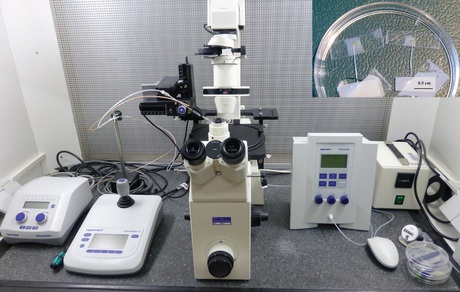Microinjection into plant cells of etiolated seedlings

For several model systems, microinjection is an established method to introduce DNA into single cells to generate transient and stable transformants. The injection of single cells within plant organs, however, is more difficult, and only a low percentage of the injected cells survives. The Eppendorf micromanipulation system has been used to inject tomato, mustard and Arabidopsis seedlings.
Usually plant cells possess a very rigid cell wall, which is a problem for microinjection since it requires stable injection capillaries with small diameters. In combination with the cellular turgor, the wall is responsible for the structural integrity of a plant seedling. The cell turgor of plants can be very high and is not only responsible for the morphology of a seedling but also plays an important role in development. Even if the injection against the high internal pressure was successful, the injury of a larger cell wall area will automatically lead to the destruction of the cell, at the latest when the needle is retreated.
The large central vacuole of a plant cell is also a problem that diminishes the chances of a successful cytoplasmic injection. The cytoplasm surrounding the central vacuole is only a few micrometres thick. As a result of the deformation of the cell wall during the injection and the sudden relaxation when the capillary penetrates the wall, the needle will often end up in the vacuole. Material injected into the vacuole is not only trapped but in many cases degraded, due to the low pH and the activity of several proteases. In addition, the tonoplast — the single membrane surrounding the vacuole — is easily injured, which leads to leakage of cytotoxic substances into the cytoplasm and hence to cell death.
Furthermore, because of multiple cell layers, light scattering and pigmentation, the optical properties of whole plant seedlings or plant organs are not optimal. Therefore, it is often difficult to identify different cell layers or even subcellular structures like vacuoles under microscopic control during the microinjection process.
To approach the described problems, Eppendorf developed a micromanipulation system equipped with very fast micromotors, variable injection parameters, high holding and injection pressure, in combination with a piezo step function. The set-up was tested for its suitability to inject plant cells — specifically tomato, mustard and Arabidopsis seedlings.
The micromanipulation system’s injection angle was adjusted to 35° and axial injection movements were performed at a speed of 3000 μm/s with a step size of 10–20 μm. These settings ensure minimal injuries of the cell wall and thus raise the survival rate after injection. The injection movement can be supported by synchronised piezo impulses when the system’s InjectMan 4 and PiezoXpert devices are electronically connected. As a marker for injection, Lucifer yellow (ly) — a water-soluble dye that easily allows discrimination between cytoplasmic and vacuolar localised fluorescence — was injected.
Typically, 5–8 injections per seedling were performed into cells of the etiolated hypocotyl. In the case of the tomato and mustard seedling injections, efficiencies of 26% and 48% were obtained. The injection efficiency for Arabidopsis seedlings was about 10% at 24 h after injection — strongly decreased compared to the tomato and mustard seedlings. However, Arabidopsis seedlings are much smaller and very fragile. As a consequence, injected cells do not only die relatively often but in many cases the whole hypocotyl is affected. Considering these challenges, 10% injection efficiency reflects a good value for Arabidopsis seedlings in our opinion.
Localised fluorescence of Iy 24 h after injection indicated that the cells were viable, but ly is no in vivo marker. Hence, we decided to inject Alexa Fluor 488-labelled histone (histone-AF488). After injection into the cytoplasm, the histones should be transported into the nucleus, where they accumulate. Histone import into the nucleus is an active process that requires GTP and intact protein complexes. Therefore, the import of histone-AF488 should only occur in living cells. The percentage of cells showing histone-AF488 fluorescence was in the same range as the observed percentage after ly injection, confirming that these cells survived the injection procedure.
The Eppendorf micromanipulation system, with its fast and precise motor movements, was thus well suited for the injection of plant cells. This includes the injection of Arabidopsis seedlings with relatively high efficiencies. Since a large collection of Arabidopsis mutants and transgenic lines is available for many research areas, microinjection of Arabidopsis cells from specific organs and tissues should, in addition to injection of other plant species, help to analyse numerous scientific questions.
Mini lung organoids could help test new treatments
Scientists have developed a simple method for automated the manufacturing of lung organoids...
Clogged 'drains' in the brain an early sign of Alzheimer’s
'Drains' in the brain, responsible for clearing toxic waste in the organ, tend to get...
World's oldest known RNA extracted from woolly mammoth
The RNA sequences are understood to be the oldest ever recovered, coming from mammoth tissue...





